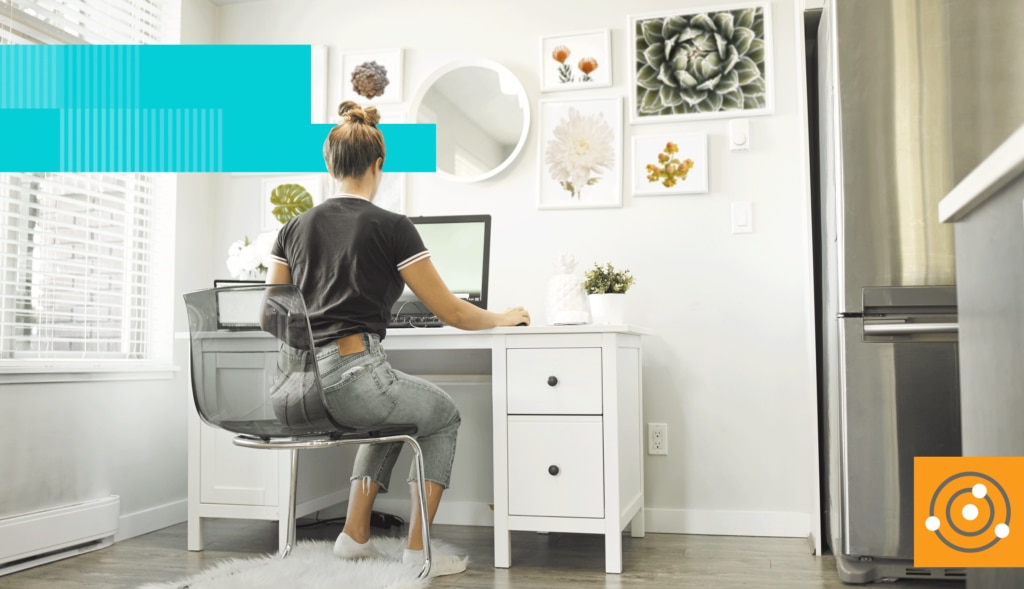- For a DIY standing option, move to an open countertop or even clear out a bookshelf and set your laptop up there for a bit.
- Another DIY standing option are those delivery boxes you might have stacking up waiting to be recycled. You can mix and match them to set your laptop at eye level for long stretches of reading, on-camera meetings, etc. Or drop it down a bit for a stand-and-type position. Or anything in-between.
- Another set of options is the devices you can use. Reading a PDF might be a strain on a laptop, but a breeze on a table or even a phone. And those types of switches will naturally allow you to also change position, seating, and location in the house.
- If you have a laptop or tablet to work from for a while, consider sitting outside on a balcony or porch. If not, consider opening a window for some fresh air and ambient noise.
- If ambient or white noise is helpful for your concentration, there are many free options online through music and video providers.
- Consider taking the next phone call on a walk. Maybe just a walk about the house to get moving—keeping your keyboard close in case you need to take a note—or if it’s a meeting you can record to make note of later, consider pressing record and then taking a walk down the street (preferably not when your neighbors are doing their lawn maintenance). Keep your pace light to prevent heavy breathing.
- Lighting is another aspect of your space, but with two elements: the ambient light in the room, and the light from the device itself.
- For the former, make sure you’re getting enough light (whether natural or not) to see your keyboard, the papers you’re working on, etc., and you aren’t fighting glare as it reflects off your screen or shines in your eyes.
- For the latter, make sure the screen is bright enough for you to see easily and clearly, but not so bright you end up with fatigue. This is where the much-ballyhooed “dark theme” may be useful, as many folks find white-letters-on-a-dark-background naturally create an easier viewing experience.
- We do recommend at least trying out a dark theme in your browser, at a minimum, as it can reduce headaches and eye strain from prolonged exposure to those bright screens.
- Chrome can be forced into dark mode (chrome://flags/#enable-force-dark); Edge can too (#enable-force-dark). Windows 10 also provides a Dark Mode option for your file explorer, menus, toolbars, etc. Additionally, there are blue light filter options in Windows 10 and on most phones to also cut down on eye strain.
- Keep safe! Your primary hazard in a home office is poor ergo practices. Evaluate your work at home layout for ergonomic best practices and make changes before you start to experience wrist or back pain. Remember: your body will tell you there’s a problem only after it’s a problem. If you already know you can’t sit for more than two hours, don’t. Once you realize you have a limit, set a timer or something to remind you to change things up before you start to ache again.
The SolarWinds Guide to Work From Home: Your Work Life at Home


Page Contents
Page Contents
In our previous post, we made some recommendations on how to maintain office community and connections with your fellow coworkers. For our extroverted readers, we hope you have taken heart from those recommendations, implemented some (or all), and maybe come up with new ways to maintain a sense of connectedness with your fellow humans at the office. In case you missed it: Finding Community and Connection.
We now want to take a few moments to discuss how to maintain your work life at home. Consider the many times you move around at the office: going to the break room to get a drink or snack, going down the hall to the restroom, going a few cubes down to talk to a collaborator on a project, walking to your supervisor or manager’s office for a 1:1 or quick chat, etc. With those all going virtual, those sporadic times throughout the day you naturally get up and take a quick walk are now gone as you continuously sit in the same space. We have pointers for injecting a little more natural movement into your new work-from-home life.
Creating a comfortable workspace means having options. In the office we naturally get up, move around, sit at different types of chairs, and in different spaces, from our desk to conference rooms to kitchen areas to couches. Look around your home and see what options you have. Your options may be limited due to the need to share space with other adults working from home or kiddos who are distance learning, the number of available rooms and surfaces, and available technology. Chances are, though, if you get a little creative, you’ll have options to break up the monotony.



